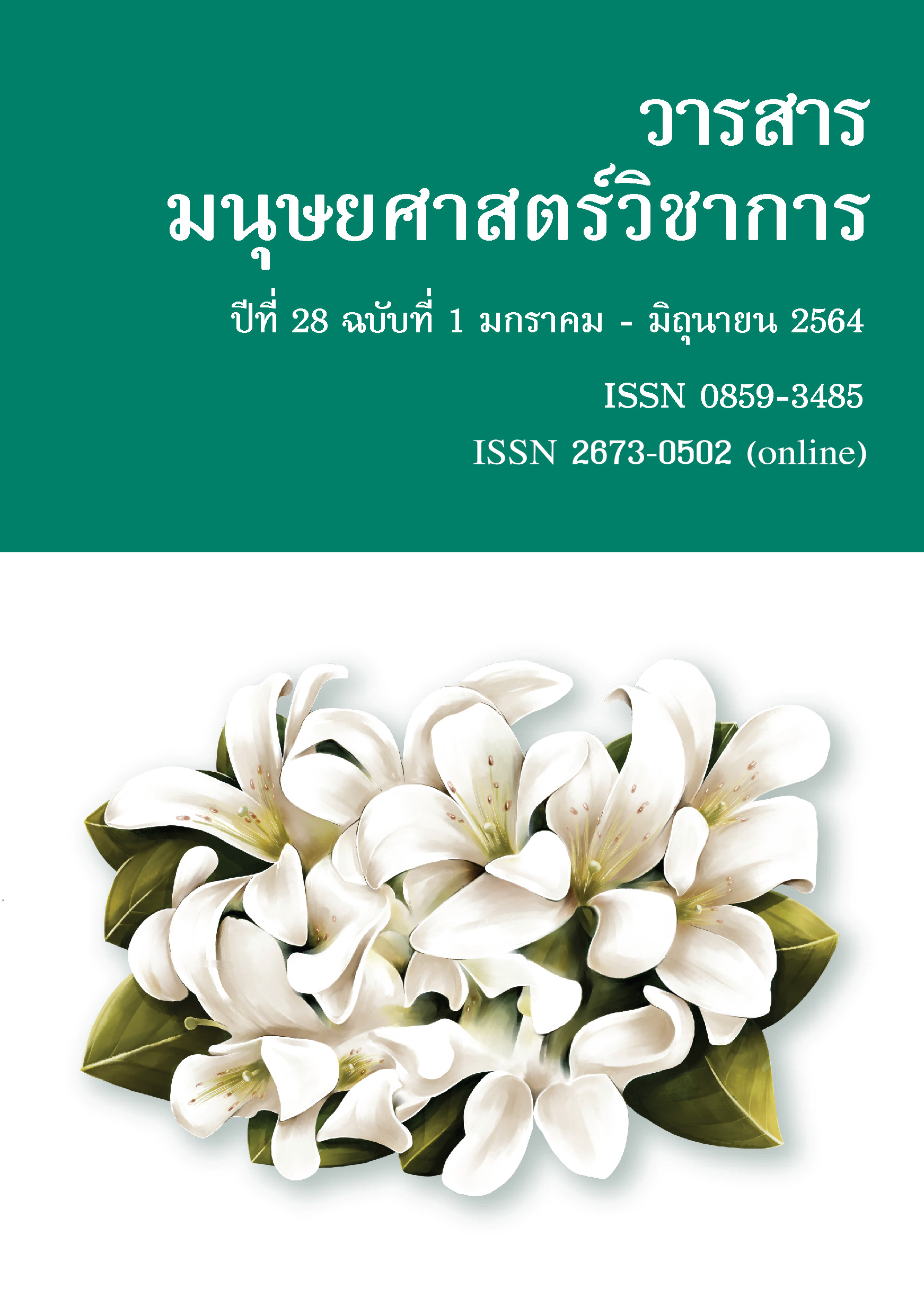The Traditional Temporal Approach and the Rhythm Metrics Approach of Thai Speech Rhythm Produced by Native Pattani Malay Speakers
Main Article Content
Abstract
This research is aimed to compare Thai speech rhythm produced by native Pattani Malay speakers with different proficiency levels in spoken Thai by using the traditional temporal approach and the rhythm metrics approach including 3 language typological classification models of Ramus et al. (1999), Grabe & Low (2002) and Dellwo et al. (2007). The speakers were native Pattani Malay speakers divided into 2 groups: superior proficiency level group
and intermediate proficiency level group in spoken Thai. There were 5 speakers in each group. All speakers were female aged between 18-21 years old. The data was collected from the continuous speech with moderate tempo from each speaker, not less than 30 seconds per 1 speaker.
The findings showed that Thai speech rhythm produced by both groups of native Pattani Malay speakers analyzed by using the traditional temporal approach tended to be syllable-timed rhythm. However, it was found that the average duration of unstressed syllables was significantly different from stressed syllables. In parts of the rhythm metrics approach, all of the three language typological classification models unclearly reflected the type of Thai
speech rhythm.
Article Details
References
ญาณินท์ สวนะคุณานนท์. (2555). ค่าระยะเวลาของเสียงเรียงในภาษาเอเชียตะวันออกเฉียงใต้: นัยสำคัญต่อการจัดกลุ่มตามแนวแบบลักษณ์ภาษา (วิทยานิพนธ์อักษรศาสตรดุษฎีบัณฑิต). จุฬาลงกรณ์มหาวิทยาลัย, กรุงเทพฯ.
ณัฐพงษ์ พึ่งน้อย. (2553). การศึกษาลักษณะทางกลสัทศาสตร์ของพยางค์ที่ได้รับการลงเสียงหนักและพยางค์ที่ไม่ได้รับการลงเสียงหนักในภาษามลายูถิ่นปัตตานีและภาษาอูรักลาโวยอ์ (วิทยานิพนธ์อักษรศาสตรมหาบัณฑิต). จุฬาลงกรณ์มหาวิทยาลัย, กรุงเทพฯ.
รัตติยา สาและ. (2534). ภาษามลายูถิ่นภาคใต้ของประเทศไทย. สงขลา: โครงการบริหารการศึกษา มหาวิทยาลัยศรีนครินทรวิโรฒ สงขลา.
อมร ทวีศักดิ์. (2530). ภาษามลายูถิ่นในประเทศไทย: ผลงานการวิจัย. นครปฐม: สถาบันวิจัยภาษาและวัฒนธรรมเพื่อพัฒนาชนบท มหาวิทยาลัยมหิดล.
Abercrombie, D. (1967). Elements of General Phonetics. Chicago: Aldine.
Arvaniti, A. (2009). Rhythm, timing and the timing of rhythm . Phonetica, 66(1-2), 46-63.
Barbosa, P. A. (2000). Syllable-timing in Brazilian Portuguese: uma crítica a Roy Major. D.E.L.T.A., 16(2), 369-402.
Bolinger, D.L. (1965). Pitch accent and sentence rhythm. In I. Abe & T. Kanekiyo (Eds.), Forms of English: Accent, Morpheme, Order. Cambridge: Harvard University Press.
Dasher, R. & Bolinger, D.L. (1982). On pre-accentual lengthening. Journal of the International Phonetic Association, 12, 58-69.
Dauer, R.M. (1983). Stress-timing and syllable-timing reanalyzed. Journal of Phonetics, 11, 51-62.
Dauer, R.M.(1987). Phonetic and phonological components of language rhythm. In Proceedings of the ICPhS XI, (pp.447-449). Tallinn, Estonia.
Dellwo, V., Fourcin, A., & Abberton, E. (2007). Rhythmical classification of languages based on voice parameters. in Proceedings of the XVIth ICPhS, (pp. 1129-1132). Saarbrücken, Germany.
Dellwo, V., & P. Wagner, (2003). Relations between language rhythm and speech rate. in M. J. Sole, D. Recasens & J. Romeo (Eds.), Proceedings of the 15th International Congress of Phonetics Sciences (pp. 471-474). Barcelona: Futurgraphic.
Deterding, D. (2011). Measurements of the rhythm of Malay. in Proceedings of the ICPhS XVII, (pp. 576-579). Hong Kong.
Grabe, E. & Low, E.L. (2002). Durational variability in speech and the rhythm class hypothesis. In Gussenhoven, C. & Warner, N. (Eds.), Laboratory Phonology, 7, 515-546.
Hyman, L.M. (2009). How (not) to do phonological typology: The case of pitch-accent. Language Sciences, 31, 213-238.
L. Thongkum. (1984, August 22-24). Rhythmic groups and stress groups in Thai. Paper presented at the International Conference on Thai Studies. Bangkok, Thailand.
Laver, J. (1994). Principles of Phonetics. Cambridge: Cambridge University Press.
Luangthongkum, T. (1977). Rhythm in Standard Thai (Unpublished doctoral dissertation). University of Edinburgh, UK.
Major, R. C. (1981) Stress-timing in Brazilian Portuguese. Journal of Phonetics, 9, 343-351.
Meireles A.R., Tozetti, J.P. & Borges, R.R. (2010). Speech rate and rhythmic in Brazilian Portuguese. In Proceedings of the Speech Prosody 2010 Conference, (pp.1-4). Chicago.
Otake, T., Hatano, G., Cutler, A. & Mehler, J. (1993). Mora or syllable? Speech segmentation in Japanese. Journal of Memory and Language, 32 (2), 258-278.
Pike, K.L. (1946). The Intonation of American English. Ann Arbor: University of Michigan Press.
Ramus, F., Nespor, M. & Mehler, J. (1999). Correlates of linguistic rhythm in the speech signal. Cognition, 73, 265-292.
Roach, P. (1982). On the distinction between “stress-timed” and “syllable-timed” languages. In D. Crystal (Ed.), Linguistic Controversies: Essays in Linguistic Theory and Practice in Honour of F.R. Palmer, (pp. 73-79). London: Arnold.
Steele, J. (1775). An Essay towards Establishing the Melody and Measure of Speech. London. Wan Aslynn Salwani Wan Ahmad. (2012). Instrumental Phonetic Study of the Rhythm of Malay (Unpublished doctoral dissertation). Newcastle University, Newcastle.
Warner, N., & Arai, T. (2001). Japanese mora-timing: A review. Phonetica, 58, 1-25.


